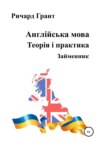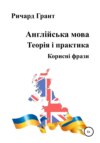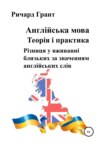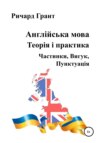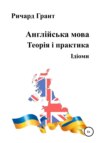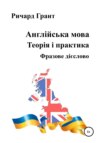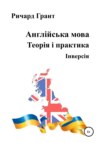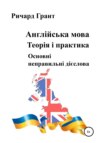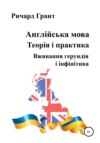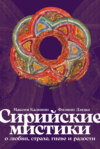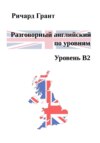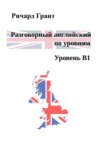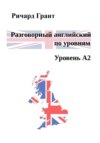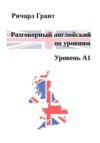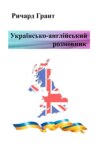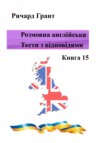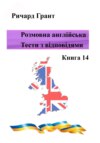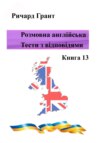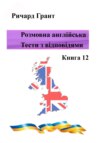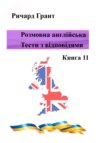Kitabı oku: «Англійська мова. Теорія і практика. Займенник»
Займенник – це частина мови, що позначає, але не називає прямо предмети, особи, їх властивості та відносини, або дає їх тимчасову і просторову характеристику.
За своїм значенням займенники діляться на особисті, присвійні, вказівні, зворотні, взаємні, питальні, відносні, невизначені, заперечнi, розділові, універсальні.
Особисті займенники
Особисті займенники – позначають особи або предмети з точки зору їх відношення до того, хто говорить.
I позначає того, хто говорить.
We позначає мовця разом з іншою особою або особами.
They позначає кого-небудь крім мовця і його співрозмовника.
Особисті займенники можуть змінюватися за особами, числами, родами (тільки в 3-iй особі) і відмінками (називний і opyдний).
Однина
Називний відмінок
1 особа – I – я
2 особа – you – ти
3 особа – he/she/it – він, вона, воно
Об'єктний відмінок
1 особа – me – мені, мене
2 особа – you – тобі, тебе
3 особа – him/her/it – його, її, йому, їй
Множина
Називний відмінок
1 особа – we – ми
2 особа – you – ви
3 особа – they – вони
Об'єктний відмінок
1 особа – us – нас, нам
2 особа – you – вас, вам
3 особа – them – їх, їм
Називний і об'єктний відмінки особистих займенників
Особисті займенники в називному відмінку в реченні зазвичай грають роль підмета:
I am Peter. – Я – Пiтер.
а в об'єктному відмінку – доповнення:
This ice-cream was bought for me. – Це морозиво купили для мене.
Також об'єктний відмінок можна використовувати, коли крім особистого займенника в реченні більше нічого немає:
Who called me? – I did. = Me. – Хто мене кликав? – Я.
Порядок особистих займенників в реченнi
Якщо до одного дієслова ставиться кілька особистих займенників, то їх порядок зазвичай такий:
– третя і друга особа перед першою:
He and I both like sailing. – І він, і я обидва любимо вітрильний спорт.
– друга особа перед третєй:
You and she should make it up with each other, you were such a nice couple. – Ви з нею повинні помиритися, ви були такою чудовою парою.
Вибір відмінка особистих займенників
Якщо особисті займенники виступають в ролі підмета, то використовується називний відмінок
He and I both like sailing. – Нам обом подобається вітрильний спорт.
Якщо особисті займенники виступають в ролі доповнення, то використовується об'єктний відмінок
Our teacher had a question for Jane (her) and me to answer. – Наш учитель хотів, щоб Джейн і я відповіли на одне питання.
Особисті займенники і рід неживих іменників
Як правило, займенники he/she (him/her) відносяться до живих об'єктів, але в художній літературі і поезії вони можуть використовуватися і в відношенні деяких неживих предметів:
He: Sun, wind, fear, love.
She: Earth, Moon, ship, boat, car, hope, justice, modesty, peace.
Крім цього, займенник she може охоплювати назви деяких країн:
I grew up in England. She will always remain in my memory. – Я виріс в Англії. Вона назавжди залишиться в моїй пам'яті.
Вправа 1
Замініть слова особистими займенниками.
Bob – he, books – they
1. a carpet 2. Mary 3. Mary and Tim 4. Mary and I 5. carpets 6. a tiger 7. tigers 8. milk 9. Robert 10. Robert and his dog 11. Helen and you 12. Mr. Nelson and I 13. Miss Jones 14. a waiter 15. a waitress
Вправа 2
Замініть в тексті виділені слова відповідними особистими займенниками (I, we, you, he, she, it, they, me, us, him, her, them).
Lisa and Roger are in Spain now. Lisa and Roger are having their holiday. Lisa and Roger live in a hotel. The hotel is very comfortable. And the beaches are fantastic. The beaches are clean and big. The sea is warm. Roger goes jogging near the sea every morning. Lisa doesn’t go with Roger. Lisa wakes up late. Lisa and Roger met their friends there. So Lisa and Roger spend all days with their friends.
Вправа 3
Заповніть пропуски особистими займенниками (I, we, you, he, she, it, they, me, us, him, her, them).
1. Look at your trainers. … are dirty. 2. Have … got a car, Sam? 3. I work for my mother. I help … in the shop. And she gives … some money. 4. Where is Cindy? I can’t see …. 5. The rat is under the table. Do you see …? 6. We have two dogs. We often take … for a walk. We also take a ball and our dogs like to play with …. 7. Our teacher is old and … has a beard. 8. Laura and I play volleyball. … do it on Sundays. 9. My brother works at the hospital. … is a doctor. 10. Peter and Anna need your help. Can you help …? 11. Robert is ill today. So we will not see …. 12. My favorite subject is History. … is very exciting. 13. Don’t sit on that chair. … is broken.
Вправа 4
Заповніть пропуски особистими займенниками (I, we, you, he, she, it, they, me, us, him, her, them).
1. I am very busy. Please don’t disturb …. 2. Tom is a good lawyer. Do you know …? 3. Here is your tomato juice. Drink …. 4. Mary and Paul can’t open the door. Go and help …. 5. Look at her. … is so beautiful! 6. I love Anna. … is my best friend. 7. It’s my sister’s birthday today. This is a present for …. 8. Where is my notebook? I can’t find …. 9. We are going shopping. Let’s go with …. 10. We are going to the beach. You can join …. 11. Give me some water. … am thirsty. 12. I like Kate’s hair. … is so thick and long. 13. Those are my nuts. Don’t eat …. 14. These are my souvenirs. … bought … in England.
Присвійні займенники
Присвійні займенники можуть бути в приєднуваній або абсолютній формі.
Приєднувана форма: мій, моя, моє, мої – my, його – his, її – her, його, її – its, наш, наша, наше, нашi – our, ваш, ваша, ваше, вашi – your, їх – their.
Абсолютна форма: мій, моя, моє, мої – mine, його – his, її – hers, наш, наша, наше, нашi – ours, ваш, ваша, ваше, вашi – yours, їх – theirs.
Приєднувані присвійні займенники (my, your, his, her, our, their) завжди використовуються тільки разом з відповідним іменником:
My cat is 5 years old. – Моєму коту 5 років.
а абсолютні (mine, yours, his, hers, ours, yours, theirs) замінюють їх собою:
What do hedgehogs drink? Mine likes milk. – Що п'ють їжаки? Моєму подобається молоко.
Присвійний займенник its пишеться без апострофа.
Займенник в присвійній формі завжди стоїть перед іменником. Якщо іменник використано разом з прикметником, то присвійний займенник ставиться перед ними:
I have lost my new keys. – Я загубив свої нові ключі.
Вправа 5
Замініть слова в дужках на присвійний займенник.
1. Her salary is higher than (his salary). 2. Your exams are easier than (our exams). 3. My pens are brighter than (her pens). 4. His song is longer than (your song). 5. Our food is healthier than (their food). 6. Their yacht is older than (my yacht). 7. This juice is fresher than (our juice).
Вправа 6
Знайдіть помилки в деяких реченнях і виправте їх.
1. The photos on the table are my. 2. It isn’t ours dog. 3. Jane is watching her favorite film. 4. His watermelon was very sweet. 5. Anna loves his husband very much. 6. How many books are there in hers library? 7. We talked about ours problems. 8. The elephant hurt his leg. 9. I met my friends at the café. 10. Is this room your? 11. That camera is their. 12. It’s my birthday, not yours. 13. This sandwich is his. 14. Theirs teacher is younger than ours. 15. Mine relatives live far from me. 16. She is a friend of my. 17. Hers garden is more beautiful than yours. 18. The world is at her feet. 19. Robert likes to spend her money on clothes. 20. Did you like mine present?
Вправа 7
Використуйте відповідний присвійний займенник.
1. You should play with … own toys. 2. Robert couldn’t use … notebook because it was broken. 3. The funny cat tried to catch … tail. 4. I hope you’ll enjoy … meal. 5. Anna drove … children to school. 6. I had … chest X-rayed. 7. We can bring … own instruments. 8. They often go to Canada because they love … nature. 9. She can’t find … glasses. 10. He didn’t give me … number.
Вправа 8
Виберіть з дужок відповідний займенник.
1. Whose slippers are these? Are they … (my, mine) or … (your, yours)? – They are … (her, hers). 2. … (Our, Ours) car is cleaner than … (their, theirs). 3. Look at this girl. She is … (his, him) wife. 4. It’s not … (her, hers) lipstick. … (Her, hers) is darker. 5. … (My, Mine) life, … (my, mine) rules. 6. Was … (your, yours) trip exciting? – … (My, Mine) was boring. 7. Can I use … (their, theirs) hairdryer? – … (Our, Ours) is out of order. 8. Mrs. Novak is a friend of … (his, him). 9. Sometimes she waters … (my, mine) flowers and I water … (her, hers). 10. I remember the street but I don’t remember … (it, its, her, his) name.
Вказівні займенники
Вказівні займенники – служать для вказівки на предмети, що знаходяться поруч (this, these) або на деякій відстані (that, those) від мовця.
This house is not mine, mine is that green cottage next to it. – Цей будинок – не мій, мій – он той зелений котедж поруч з ним.
Вказівні займенники мають форму однини і множини.
Однина
this – цей, ця, це
that – той, та, то
Множина
these – ці
those – тi
Використовувати вказівний займенник для прямої вказівки на якусь особу, крім ситуації знайомства, вважається нечемним:
Mom, dad, this is Jennifer, my girlfriend. – Мамо, тату, це – Дженніфер, моя подружка.
This is our secretary. – Це – наша секретарка. (зневажливе відношення)
Вказівні займенники як посилання на час
Вказівні займенники можуть описувати не тільки близькість в просторі, але і в часі:
займенник this позначає момент розмови або поточний відрізок часу:
This summer is so rainy. – Це літо таке дощове.
займенник that описує час в минулому або майбутньому:
Many small companies went bankrupt that summer. – Того літа збанкрутувало багато дрібних компаній.
У таких фразах, як this country, this city, займенник this позначає країну, в якій знаходиться мовець, тому при його перекладі потрібно враховувати контекст.
I find the system of education in this country too confusing. (з британської газети) – Я знаходжу британську систему освіти занадто заплутаною.
Крім цього, до вказівних займенників можна віднести such, який вказує на певну якість предмета.
Such small details will make your flat look cozy. – Такі невеликі деталі можуть зробити вашу квартиру затишнішою.
Вправа 9
Поставте this або these.
1. … cream isn’t good. 2. … is my air-plane ticket. 3. … books belong to his children. 4. … river is the longest in the region. 5. … trainers were made in Italy.
Вправа 10
Поставте that або those.
1. … tomatoes are not fresh. 2. … bag is mine. 3. … letters are for Mike. 4. … is our bus. 5. … dogs bark every night.
Вправа 11
Поставте this, that, these або those.
1. Could you pass me … dictionary beside you? 2. … jeans over there are quite cheap. 3. … apples are much sweeter that those ones. 4. Look here! Do you like … ring? 5. Do you know … woman in black over there? 6. … shoes are very tight. I must take them off. 7. How much are … teddy-bears in the shop-window? 8. … tower looks so small because it’s far away. 9. … dolphins we saw in the sea were so funny. 10. … ice-cream I am eating is my favourite.
Вправа 12
Змініть речення в однині на множину, або навпаки.
That girl is my neighbor. – Those girls are my neighbors.
1. This man is quite old. 2. That is our teacher. 3. Pass me those spoons, please. 4. Is this your key? 5. Look at this tulip. 6. These tests are too difficult for me. 7. Who is that woman near the shop? 8. This dress looks great. 9. Whose cars are these? 10. Those glasses are broken.
Вправа 13
Поставте наступні словосполучення в множину.
This magazine, that sticker, this stamp, that sandwich, this poster, this teacup, this egg, that wall, that picture, this foot, that mountain, this lady, that window, this man, that match, this knife, this book, this family, this pie, that answer, that apartment, that teacher, that comedy.
Вправа 14
Поставте наступні речення в множину.
1. This is a spider. 2. Is this a sofa? 3. That isn’t a goose. 4. That is a snail. 5. Is this a bookcase? 6. This isn’t a mouse. 7. This is a space film. 8. Is this a man? 9. That is a cartoon. 10. Is that a ball? 11. This is a star.
Вправа 15
Поставте наступні речення в множину.
1. Is that a train? 2. This is a boy. 3. Is that a plane? 4. This is a baby. 5. That is not a king. 6. That is a plate. 7. That is not a queen. 8. That is a flower. 9. That is not a bus. 10. That is a bookshelf. 11. This isn’t a mountain.
Вправа 16
Виберіть правильний варіант відповіді.
1. This/That puppy over there is mine. 2. This/These flowers are beautiful. 3. This/These is our friend John. 4. Those/That books are not interesting. 5. These/This children are noisy.
Вправа 17
Перекладіть англійською мовою.
1. Мені не подобається це плаття. 2. Ти знаєш того хлопця? 3. Хто ці люди? 4. Я не можу забути про ті дні. 5. Куди ти їдеш цьoго літа?
Зворотні займенники
Зворотні займенники – використовуються, коли особа або предмет виконують дію, спрямовану на саме себе.
Little Timmy fell and hurt himself. – Малюк Тіммі впав і забився.
Однина
1 особа – себе, собi – myself
2 особа – собi – yourself
3 особа – себе, сам/себе, сама/себе, сам, сама, само – himself/herself/itself
загальна особа – себе, собі, сам, сама – oneself
Множина
1 особа – собі, себе, собою – ourselves
2 особа – себе – yourselves
3 особа – себе, собі, самі – themselves
Зворотні займенники можуть служити для емоційного посилення
But you yourself saw it! = You saw it yourself! – Але ж Ви самі все бачили!
Зворотний займенник oneself можна використовувати стосовно до всіх людей:
The only thing I can recommend to achieve success is to treat oneself with self-criticism. – Єдине, що я можу порадити, щоб домогтися успіху – ставитися до себе з самокритикою.
Зворотні займенники не використовуються після дієслів feel, afford, wash, bath, shave, (un)dress, change (clothes).
I feel terrible. – Я страшенно себе почуваю.
I’d like to have a Porsche but I cannot afford it. – Я хотів би мати Порше, але я не можу собі цього дозволити.
I dressed quickly, had my breakfast and left for work. – Я швидко одягнувся, поснідав і поїхав на роботу.
Вправа 18
Поставте необхідний зворотний займенник..
The water is hot, don’t burn …. – The water is hot, don’t burn yourself.
1. I am angry with …. 2. Can you do many things …? 3. You see you've cut … again. Be more careful. 4. He fell down and hurt …. 5. Does your friend Nick often talk to you about …? 6. I think that poor dog hurt …. 7. Tell me more about …. 8. Did your mother buy anything for … last week? 9. He came into the room and introduced …. 10. She believes in …. 11. Are you always sure of …? 12. We didn't know where to hide …. 13. We are sure of …. 14. Can a little child take care of …?
Вправа 19
Поставте необхідний зворотний займенник.
1. She is very sure of …. 2. They did everything …. 3. Do you believe in …? 4. Children, you can't do that …. 5. Did you translate the text …? 6. Did the pupils answer all the questions …? 7. They always speak only about …. 8. I saw everything …. 9. Did you make the dress …? 10. We should always believe in …. 11. The knife was sharp, and she cut …. 12. Babies cannot look after …. 13. They introduced …. 14. I tried to control ….
Вправа 20
Знайдіть помилки в деяких реченнях і виправте їх.
1. My sister taught himself to swim. 2. Anna repaired the chair herself. 3. The children are making themselves something to eat. 4. I hurt me when I fell down the stairs. 5. We're meeting ourselves at 8.00 this evening. 6. We're enjoying ourselves very much.
Вправа 21
Дайте відповідь на питання, маючи на увазі, що всю роботу люди зробили самостійно.
Who bought that book for him? – He bought it himself.
1. Who cooked your breakfast this morning? 2. Who helped them to translate the text? 3. Who helped the little girl to dress? 4. Who helped you to find the way? 5. Who cleaned your classroom? 6. Who washes your clothes? 7. Who broke his tape-recorder? 8. Who built their house? 9. Who helped her to do maths? 10. Who planted the garden in front of your house?
Вправа 22
Заповніть пропуски зворотними займенниками, де це необхідно.
1. All our friends enjoyed … at his birthday party. 2. I often speak to … when I'm in bad mood and alone. 3. Polly and Nancy, help … to sweets and juice. 4. Concentrate … if you don't want to fail your exam. 5. They haven't decided yet where they'd meet …. 6. Little Polly is only two but she can dress …. 7. She got up, washed … and left the house without disturbing anyone. 8. I'm not angry with him. I'm angry with …. 9. Relax … when you dance. 10. They never think about other people. They only think about …. 11. Who went with her? – Nobody. She went by …. 12. Let's hide … under that tree. The rain is so heavy. 13. He feels … not well today. 14. Don't take him to the party. He'll spoil everything …. 15. We didn't know who that young guy was. He didn't introduce …. 16. It's windy, you may catch cold …. 17. Children, take the towel and dry ….
Ücretsiz ön izlemeyi tamamladınız.
